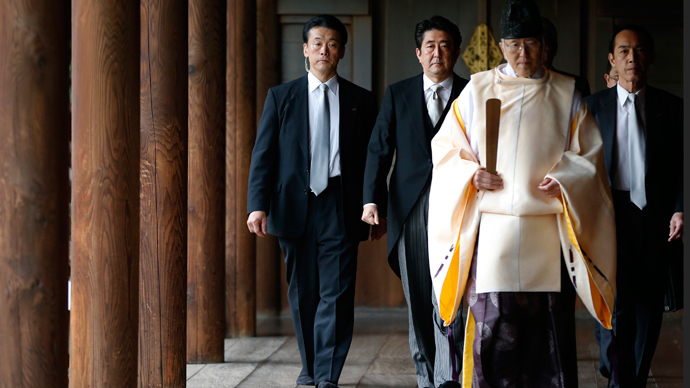Yasukuni shrine visit: Japan beating wardrums after years of pacifism

This week Japanese Prime Minister Shinzo Abe visited the controversial Yasukuni shrine in Tokyo – a move which was slammed by Singapore, South Korea and China. Why this harsh reaction and what is Abe’s message behind the move?
Imagine the furore if German Chancellor Angela Merkel decided to visit a German war memorial that honored members of the SS and their role in the Second World War. It would immediately result in an avalanche of protest by the governments and citizens of those countries, which endured crimes of unspeakable barbarism at the hands of this fascist military organization – and understandably so.
The outrage expressed by China and South Korea over the recent visit to the Yasukini shrine in Tokyo honoring Japan’s 2.5 million Second World War dead – including mass murders and convicted war criminals – by Japan’s Prime Minister ShinzoAbe has to be viewed in the same context. It belongs in the same category as a German Chancellor paying homage to the SS.
Due to the attention given in the West to the European theater of the Second World War, the extent of the atrocities and war crimes committed by the Japanese armed forces during their occupation of South East Asia and China has never really been appreciated outside the region.
The most notorious of those atrocities took place in December 1937, when the Japanese Imperial Army marched into Nanking – the then capital of the Republic of China – and proceeded to slaughter 300,000 of the city’s 600,000 residents over a six-week period. The majority of the victims were civilians and before they were murdered most of the women and girls – some as young as 8 years of age and other as old as 70 – were gang raped. It is estimated that anything between 20-80,000 women suffered this fate. Pregnant women weren’t spared either, with some of them having their stomachs cut open and their fetuses ripped out. Many of the women who were spared this ordeal were press ganged into working as prostitutes – comfort women – for the pleasure of Japanese soldiers thereafter.
Is it any wonder that the Rape of Nanking continues to exert such strong emotions in China to this day?
From the mid 1930s up to the Japanese surrender in 1945, Japanese forces were responsible for the mass slaughter and enslavement of millions of prisoners of war, civilians, and non Japanese in every country they occupied throughout Asia – i.e. China, Korea, The Philippines, Singapore, and Burma. Imbued with the ideology of racial superiority, the Japanese Imperial Army viewed and treated the people they occupied as untermenschen, exactly as their SS counterparts did in Eastern Europe.
In the case of Japan, this was a process that began with the nation’s rapid industrialization and modernization under the Meiji Restoration, beginning in the late 19th century. It was a process begun in response to the influence of the West, whose global reach on the back of its own process of industrialization had seen it carve up the globe into empires and colonial possessions. Japan was intent on emulating the example of the West in Asia, evincing a cultural, political, and racial disdain for its non Japanese neighbors as they lagged behind.
Today, seven decades on from the horrors of the Second World War, a growing trend towards a resurgent nationalism is evident within Japan after decades of self-imposed pacifism. With China knocking Japan off its perch as the economic, cultural, and geopolitical powerhouse in the region over the past decade, and with the concomitant decline of US economic hegemony in the same period, Japan’s political leaders have responded with an increasingly muscular worldview, involving the ramping up of the country’s military hardware and armed forces, reflected in an increase in defense spending by 2.2 percent over last year to $45.8 billion. On its latest military shopping list are F-35 fighter jets, a new destroyer, a 2,900-ton submarine, SH-60k patrol helicopters and P-1 patrol aircraft, along with surveillance drones.
Driving this increase in military spending is the Japanese Prime Minister. Since coming to office in 2012, ShinzoAbe has committed his government to raising the nation’s military profile in the region and to revising Japan’s pacifist constitution. His recent visit to the Yasukini shrine is part of this process.
Underpinning the heightened tensions between China and Japan is of course their ongoing territorial dispute over a small set of islands in the East China Sea – the Diaoyu Islands in China and Senkaku Islands in Japan. In November, an air defense zone set up by China to protect the islands and their adjacent waters was violated by Japanese and US military aircraft. Making this dispute more serious and intractable is the strong likelihood of significant energy and mineral deposits in the area.
Playing a nefarious role in the background to this regional dispute is Washington. Japan is a key US ally in a region which US hawks – both Democrat and Republican – have identified as a key priority when it comes to US foreign policy. The need to counter China’s astounding economic growth, and with it a growing assertiveness globally, has seen the US and Japan engage in joint military exercises recently in yet another act of provocation against China.
Under the Bush administration, in the wake of 9/11, the US focused much of its attention on establishing a permanent military presence in Central Asia - specifically in the form of bases in Uzbekistan and Kyrgyzstan - enabling easier access to Afghanistan for US military personnel, supplies, and airstrikes while exerting pressure on China. The US suffered a setback in the summer, however, after its presence in Kyrgzstan became unsustainable in the face of the Kyrg government’s demands for increased rent for the privilege. The prospect of Russia and China taking over the base when the US vacates next year will not sit comfortably with US military strategists.
Washington’s priority of solidifying its military alliance with Japan as a counterweight is clear, evidenced in the military agreement reached between both countries in October to expand Japan’s military capability in the region. After the agreement was finalized, US Secretary of Defense Chuck Hagel said: “Our bilateral defense cooperation, including America’s commitment to the security of Japan, is a critical component of our overall relationship and to the Obama administration’s rebalance to Asia-Pacific.”
A resurgent Japan, acting as a US proxy, is part of this process of 'rebalance'.
The statements, views and opinions expressed in this column are solely those of the author and do not necessarily represent those of RT.
The statements, views and opinions expressed in this column are solely those of the author and do not necessarily represent those of RT.













